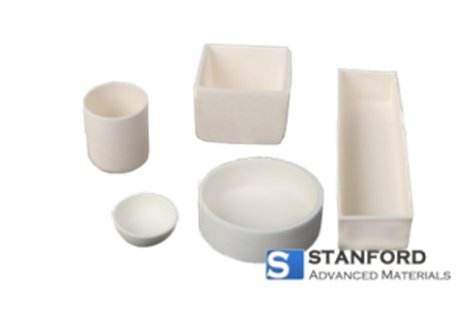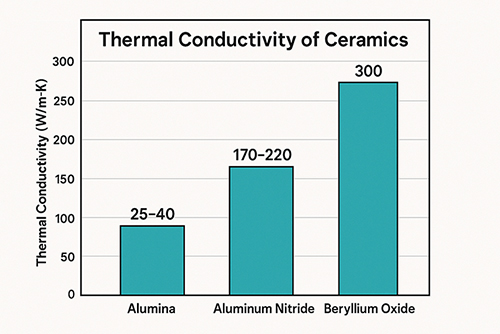How Many Oxide Structural Ceramics Do You Know?

Since used in the mobile phone back cover, zirconia ceramics are known to us. But how many commonly used oxide structural ceramics do you know besides zirconia?
Alumina Ceramics
Alumina ceramics is a kind of ceramic material mainly composed of alpha-al2o3 crystal, which is one of the most widely used ceramics currently.

Applications:
Mechanical industry: the alumina ceramics used as cutting metal ceramic cutter, wire drawing die, ball bearings, grinding media and all kinds of wear-resistant porcelain;
Electronic industry: used as ceramic substrates, vacuum switch ceramic shell, insulating ceramics for vacuum electronic devices, etc.;
Semiconductor manufacturing: used as silicon wafer chuck, hook; the environment of high-temperature heating elements, such as the crucible, thermocouple protection tube, furnace tube, etc.;
Paper industry: the wiper plate, desander, etc;
Chemical industry, light industry, and textile: fire pump, mechanical washer, nozzle, wear-resisting liner, liner board, water valve, etc.;
Medical areas: artificial joint, etc.
Beryllium Oxide Ceramics
Beryllium oxide ceramic is a kind of ceramic material mainly composed of beryllium oxide, which is a clear hexagonal structured crystal with stable density and without crystal shape shift. The melting temperature of beryllium oxide ranges 2530 ~ 2570 ℃, the density of which is 3. 3 g/cm3 and Mosh hardness is 9, besides that, it has a high-temperature vapor pressure and low evaporation rate.

Applications:
Electronics industry: Beryllium oxide ceramic is used as the high-power cooling device, electric vacuum components, hybrid integrated circuits, high power semiconductor devices;
Metallurgical industry: used as the beryllium crucible and containers for smelting rare metals and high-purity metal like platinum, vanadium, etc;
The nuclear industry: used as nuclear reactor structure under normal and high temperatures, including the neutron moderator, radiation protection materials, the control rods, and UO2 ceramic combined into nuclear fuel;
Beryllium oxide ceramic also used to make transparent BeO ceramics serves as a storage device for microwave substrates and integrated circuit boards, also, applied to the instrument of the high-temperature observation window.
Magnesium Oxide (MgO) Ceramic
Magnesium oxide ceramics are ceramic with magnesium oxide as the main component. It belongs to the cubic crystal system and the melting point of which is 2800 ℃. Magnesium oxide is volatile in temperature of higher than 2300 ℃, therefore, magnesium oxide products are generally restricted to use below 2200 ℃.
Application:
Magnesium oxide ceramics can be used as weakly alkaline materials, crucibles for smelting metals, the mold for casting metals, protective tubes for high-temperature thermocouples, and furnace lining materials for high-temperature furnaces.
Transparent magnesium oxide ceramics can be used as radar cover, infrared detector cover, chemical window material, etc. However, thermal shock resistance of which is so poor that difficult to be sealed by ceramic metal, and it is easy to evaporate in the air, so it is not suitable for high-pressure sodium lamp.
Mullite Ceramics
Mullite ceramic refers to the ceramic of the main crystal phase for mullite, which is a mineral form of aluminum silicate. It is known for its high melting point, excellent thermal shock resistance, and low thermal expansion coefficient.
Application:
Due to the excellent thermal properties and mechanical properties while the not outstanding room temperature performance of mullite, high-purity mullite ceramics are mainly used in the high-temperature environment:
High-temperature insulation parts, such as used as cylinder head floor in the advanced ceramic engine;
Used as heat exchanger components, such as core tube, thermocouple tube furnace, and crucible, used for sintering ceramic element at more than 1000 ℃ instead of stainless steel;
Mullite ceramics have good corrosion resistance of gases and airtightness, which is suitable for the production of protective tubes.
High-temperature pads and nozzles.
Zirconia Toughened Alumina (ZTA) Ceramics
Zirconia toughened alumina ceramics is a kind of compound material that is used to induce phase change with the toughening of zirconia and to inhibit the growth of the grain of alumina body. Compared with a single alumina ceramic, it has a higher flexural strength and fracture toughness.

Application:
ZTA Composite ceramics can be made of ceramic tools or used for the processing of cast iron and alloy
ZTA ceramics can be used to make the interface structure of engineering ceramics to extend the service life of engineering materials.
Used to make wear-resistant porcelain ball.
Used as a biomedical material for the reconstruction and repair of hard tissue (teeth).
Zirconia Toughened Mullite (ZTM) Ceramics
Zirconia toughened mullite ceramic is a kind of zirconia phase change toughened ceramics with mullite as the matrix.
Mullite has a high temperature, high strength, good fracture toughness, chemical stability and thermal shock resistance. Adding zirconium dioxide toughened mullite, there are two toughening mechanisms of stress-induced phase change and microcrack toughening.
Application:
Aerospace Industry: ZTM ceramics are used to manufacture parts for aircraft engines, gas turbines, and other high-temperature applications in the aerospace industry. Their excellent high-temperature strength, toughness, and thermal shock resistance make them ideal for these applications.
Medical Industry: ZTM ceramics are used to manufacture dental implants and other medical devices due to their excellent biocompatibility, wear resistance, and strength.
Electronic Industry: ZTM ceramics are used in the production of electronic components such as insulators, substrates, and circuit boards due to their excellent electrical insulation properties and high-temperature stability.
Foundry Industry: ZTM ceramics are used as crucibles and other furnace components in the foundry industry due to their excellent resistance to thermal shock and high-temperature strength.
Chemical Industry: ZTM ceramics are used in the production of chemical pumps, valves, and other equipment due to their excellent chemical resistance, wear resistance, and strength.
Conclusion
In conclusion, oxide structural ceramics refer to various simple oxide ceramics with a melting point higher than that of SiO2 crystal. Besides zirconia, other commonly used oxide structural ceramics are alumina ceramics, beryllium oxide ceramics, magnesium oxide (MgO) ceramic, mullite ceramics, Zirconia Toughened Alumina (ZTA) ceramics, and Zirconia Toughened Mullite (ZTM) ceramics. These ceramics find applications in various industries such as mechanical, electronic, semiconductor, paper, chemical, light, textile, metallurgical, nuclear, and aerospace industries. Each ceramic material has unique properties and applications that make them suitable for different industrial needs.
Advanced Ceramic Materials (ACM) supplies high-quality zirconia ceramics and related products to meet our customers’ R&D and production needs. Please visit https://www.preciseceramic.com/ for more information.
{{item.content}}
LEVE A REPLY
{{item.children[0].content}}
{{item.content}}
LEAVE A REPLY
SUBSCRIBE OUR NEWSLETTER
- Boron Nitride in Cosmetics: Enhancing Performance and Sensory Appeal
- Maximize MOCVD Yield and Purity with Hexagonal Boron Nitride Setters
- What Are the Advantages and Uses of Boron Nitride Ceramic Sheet?
- The Compression Annealing Advantage for Pyrolytic Boron Nitride
- Beyond Insulation: The Surprising Spectrum of Ceramic Thermal Conductivity











